
|
Lorna Mills and Sally McKay
Digital Media Tree this blog's archive OVVLvverk Lorna Mills: Artworks / Persona Volare / contact Sally McKay: GIFS / cv and contact |
View current page
...more recent posts
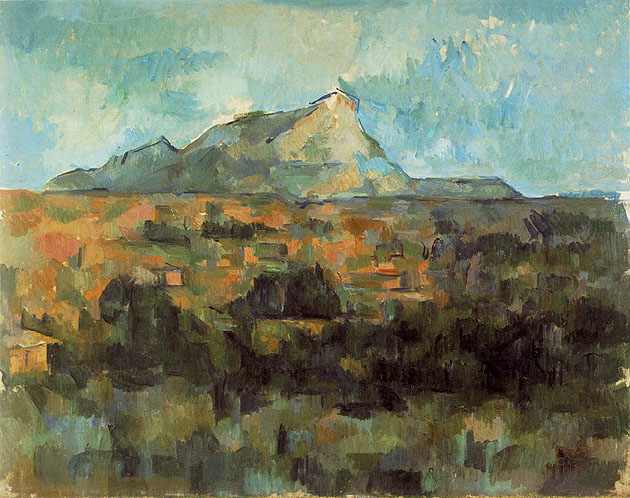 Paul CÚzanne, Mont Sainte-Victoire Seen from Les Lauves (1904-06) [source]
Paul CÚzanne, Mont Sainte-Victoire Seen from Les Lauves (1904-06) [source]Excerpt from a longer essay I am working on: In 1905, the painter Paul CÚzanne was pushing himself relentlessly at the edges of perception, tossing torn paintings out the window in frustration (according to legend) and casting new depictions of space onto canvas with an unprecedented and hard-won level of abstraction. That year Einstein published three papers: one on Brownian Motion (providing a mathematical explanation for the apparently random, zig-zagging motion of particles suspended in liquid), one on special relativity (introducing the mind-bending physical law that the time and space are inextricably connected, such that the faster an object moves in space, the slower it moves in time), and a paper stating that light, previously considered exclusively as a wave, sometimes behaves like stream of discrete particles, tiny bundles or "quanta" of energy. The wave/particle theory laid the groundwork for quantum physics.
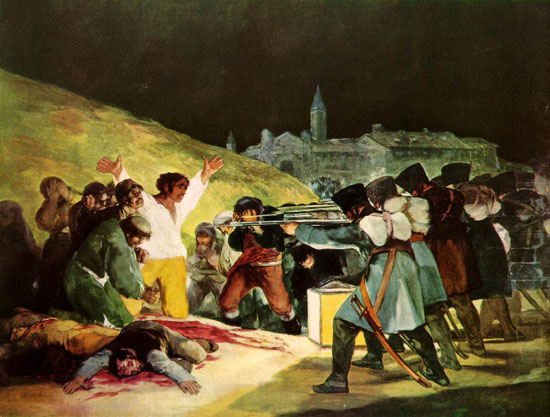
Goya, Executions on the Third of May, 1808 (1819). [source]
Techniques of interpretive illustration as used in art, according to James O. Young (see previous post), p. 82-84:
Selection: "A work of art can, by judicious use of selection, bring an audience to focus on objects which have been overlooked, or thought unworthy of careful attention."
Amplification: "Amplification is a technique common in all forms of satire. It is found in the paintings and engravings of Hogarth and in the plays of Sheridan. In general, amplification highlights certain properties and thereby draws attention to them."
Simplification: "Every object possesses a great many properties. When simplification is used in the representation of an object, some of these properties are down-played or eliminated. [...] One sub-species of simplification may be called idealisation. Idealisation is simplification that removes all of an object's imperfections."
Juxtaposition: "When juxtaposition is employed, two or more objects are simultaneously represented. [...] Classic instances of juxtaposition are found in Jane Austen's novels. She frequently juxtaposes a superficially engaging but morally flawed character with a type who, though lacking certain social graces, has true worth."
Correlation: "Correlation involves the representation of an object in such a way that audiences will see it in relation to a second object. The difference between juxtaposition and correlation is that juxtaposition involves the representation of both objects, while in correlation the second object is not represented. A good example of correlation is provided by Goya's The Third of May 1808 in Madrid: Executions on Principe Pio Hill. Here a Spanish patriot is represented in such a way that he resembles and recalls the crucified Christ."
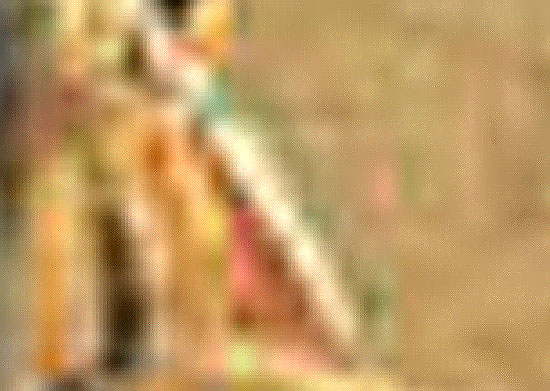
James O. Young (2001): The sciences and the arts are not completely dissimilar forms of inquiry. Art and empirical science have a common foundation: both begin with careful observation. Before artists or scientists can represent anything they must observe aspects of the world. [...] The arts and sciences resemble each other in another respect. They both represent objects in such a way that, ideally, insight is provided into the objects represented. [...] The representations produced by the arts and sciences can each contribute to knowledge of some matter in two ways. That is, the representations these modes of inquiry produce have two cognitive functions. They may provide testimony about objects and they may interpret objects. Testimony is simply a record of observations. Interpretation is the attempt to understand this record, either by means of theories or in some other way. [...] Since arts and sciences employ different sorts of representation, they perform each of the cognitive functions in different ways.
Testimony: "We may identify semantic testimony and illustrative testimony.To provide testimony is simply to provide information. The sciences frequently provide information by means of statements. [...] The testimony in works of art, on the other hand, is provided by means of illustrations from which information can be derived. So, for example, a painting by Canaletto is testimony about the appearance of San Marco.
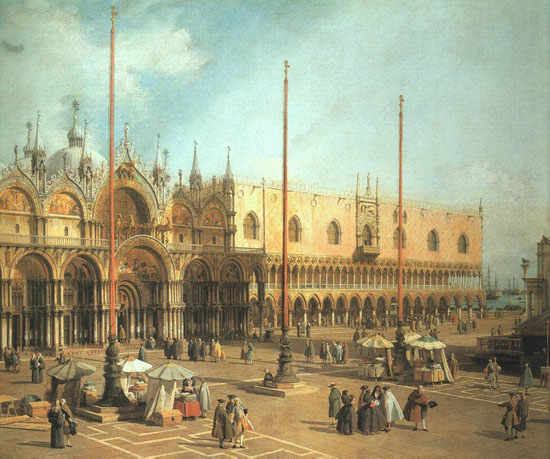
Canaletto, Piazza San Marco - Looking Southeast (1735-40). Photo: Carol Gerten-Jackson [source]
Interpretation: "The sciences interpret objects by means of theories or models. The arts, on the other hand, do not. This is one of the fundamental differences between forms of inquiry which employ illustrative representation and those which employ semantic representation. Instead, the arts provide what I will call a perspective on objects. A perspective is a way of conceiving of an object that can enhance understanding of the object. [...] Both scientific theories and the perspectives provided by the arts are in need of justification. They ought not to be accepted on the word of a scientist or an artist. In other words, theories and perspectives need to be demonstrated and a great deal of what goes on in the arts and sciences is demonstration. An analysis of demonstration, and the form it takes in the arts, is an important part of the epistemology of art.
We need to begin by distinguishing between two quite different sorts of demonstration. I will call the first type illustrative deomonstration or showing. The second sort may be called rational demonstration. Rational demonstration is demonstration by means of an argument. Illustrative demonstration, on the other hand, is non-rational. ... [I]llustrative demonstration places one in a position where one can recognise something. Artworks cannot provide rational demonstrations of perspectives, but they can provide illustrative demonstrations of the rightness of a perspective.
Excerpts from James O. Young, Art and Knowledge (London and New York: Routledge, 2001) p. 66-69
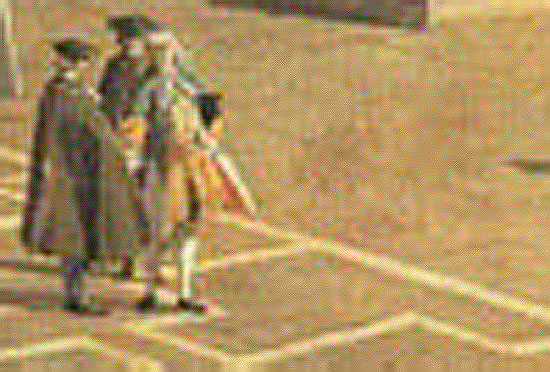
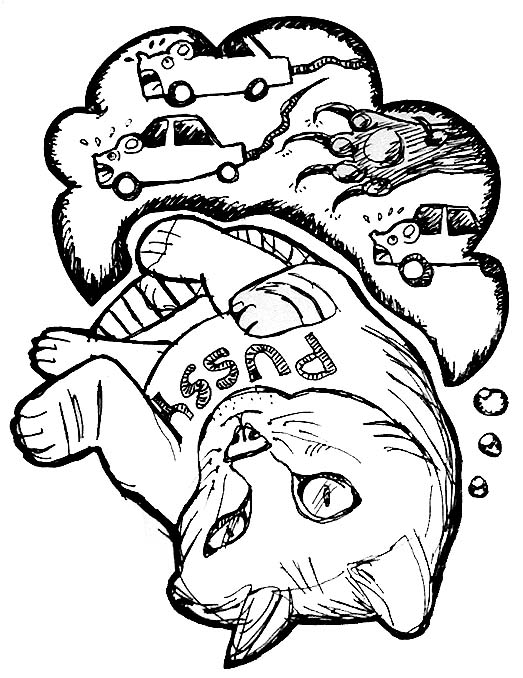
Notes on this blog: the tone has been changing here, as regular readers will have noticed. This is due to the fact that my day-work right now requires more long-term writing attention, which doesn't go so well with the bursts of research and articulation that hardcore blogging requires. I am sorry for the current lack of traditional art reviews and reportage, but I am not going to force it. For now, I will continue posting bits of my research, musing notes, and miscellaneous pictures.
I was moved and impressed by Steve Kurtz and Greg Bordowitz during their talk here on Saturday night. Kurtz is sardonic and eloquent and gave a good slide show on the history of Critical Art Ensemble's troubles with authority. The upshot being that art works that threaten to disrupt the flow of capital are more likely than not to draw negative attention from the powers that be. Bordowitz is like a can of pressurized charisma. He was passionate and articulate and a lot of what was said is sticking with me:
1) USA is working hard right now to establish an 'enemy within.' This case against Kurtz is a test for them to see if they can go after rebellious white middle class intellectuals as well as visible minorities and protestors. If the US government can gain enough oppressive power at home to subjugate its own middle class, then they are operating with even fewer checks and balances...bad news for US citizens (obviously) and super-bad news for the rest of us in the world too. The CAE Legal Defense Fund is in solidarity with other who are persecuted under the Patriot Act, and hopes to expand after the case in order to help more people.
2) There was refreshing talk about protest and the nature of rebellion. CAE has held for years that protesting in the streets is the not necessarily always the most effective way to voice dissent. Says Bordowitz, "I don't feel like performing rage anymore. I feel like performing deppression," and "the politics are here in this room, in what we say later to our co-workers and students." Says Kurtz, "what's important is the process of coming to the decision that you will no longer go along with what you know is wrong."
3) The question was raised, has rebellion itself been commodified to the extent that it is no longer possible to rebel? The answer was refreshingly sincere and complex. Yes it is possible, even vitally necessary to rebel. Kurtz spoke about how rebellion is a dynamic, an ongoing relationship with power, and that success is measured in increments, over time, as part of a continuum rather than a coup. Bordowitz pointed out that we operate under a false myth that, in any field, if we perform to competency we will succeed. In fact, very qualified, hard working intelligent people are not succeeding. So the question is raised...rebellion may be flawed but as opposed to what?
4) Bordowitz noted a rise of anti-intellectualism -- scary, and close to home -- as many charge that the use of expert language (research language, as Bordowitz put it) is elitist and exclusive, when in fact it can simply be seen as people communicating with one another in the technical terminiology of their trade. This is something that's been nagging at me more and more recently in all this (my) talk of accessibility and general audiences for art. I like intellectuals...they ("we," if I may presume...) come up with good and interesting ideas.
There was lots more good stuff too. If you attended the talk and anything stuck out for you (anything other than the stellar and mind-blowing job of moderation by your's truly) please post it in the comments. And if you want to help out with the legal defense fund, please click here and find out more.